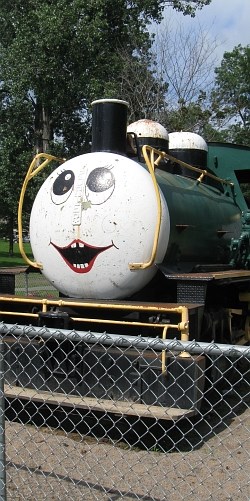Sault Ste. Marie City Council has decided to designate the locomotive engine in Bellevue Park as culturally and historically significant.
This means the beloved little train engine, popularly known as Porter, can no longer be used as play equipment.
In addition to granting the historic designations, City Council also agreed last night to seek funding to restore the locomotive to its original state.
This means no more painted face - no more tears - and no more playing on the fireless engine once known as #10. The City now becomes responsible to conserve the Bellevue Park locomotive and to tell its story, says a municipal heritage committee report to City Council.
The committee recommended that councillors designate the locomotive and the land it sits on as culturally and historically significant under Part IV of the Ontario Heritage Act.
Last night, City Council resolved to do just that, beginning the process of restoring Algoma Steel Co. Engine Number 10 to its former glory, then housing it in an appropriate shelter.
Council also agreed to make every effort to ensure that visitors to Bellevue Park remember the engine was called Porter after the owner of the company that made it, H. K. Porter; that it served Algoma Steel Co. from 1943, when it was made, to 1967, when it was donated to the City of Sault Ste. Marie; and, that it's one of only two engines like it still left in Canada.
The historical information about Algoma Steel Co. Engine Number 10 came from a report prepared by David Ellis and Ted Wall (with special assistance from Graeme Ellis).
That information, along with the testimony that the train was a beloved piece of playground equipment in the park for 40 years, will be included on a plaque that will tell the locomotive's story.
Excerpts from the report follow.
************************* Description of the locomotive from the designation report
This train shuttle engine was originally known as Engine Number 10, built for the Algoma Steel Corporation.
This engine was built in 1943, with a configuration of 0-4-0F and a weight of 48,000 pounds, to be used as an on-site shuttle engine at the plant.
When it was retired in 1967, it was given to the City of Sault Ste. Marie and has been located in Bellevue Park since that time.
This engine is unique, in that it was custom built for the Algoma Steel Corporation and also was of "fireless" type.
This configuration is quite rare and according to the Canadian Railroad Museum, is one of only two in existence in Canada today and considered to be in the best condition (although it has been modified with the controls welded closed).
At this time little is known of the operational history of Locomotive Number 10, although it is believed principally to have switched incoming carloads of coal and delivered finished products to switching yards on the Algoma site.
It carried a storage pressure of 150 pounds per square inch and a working pressure of 60 pounds, making it a shuttle engine, of great usefulness in the steel mill.
It currently is displayed on the grounds of Bellevue Park, where it has, up to recently, been used as a playground play structure.
As it has been located on the park site for 40 years, it has become a community icon, not necessarily for its historic importance, but as a place in the community that generations of children have played.
************************* Statement of Cultural Heritage Value
This train shuttle engine's cultural value lies as both an example of industrial heritage, as well as, its significance as a cultural icon with community for the last forty years, whilst it was housed in Bellevue Park.
The industrial heritage component is that the engine is an example of the then growing and vibrant steel industry present in the WWII years and beyond to the early sixties.
However, technology and cost efficiencies made the technology redundant thereafter.
The engine's cultural heritage also lies in its use as an artifact and play structure in Bellevue Park.
Its new use has provided a play area for children and their families for almost half a century.
From very wide public support when the engine was declared unsafe and possibly be scrapped, it is evident that it was more than just another piece of playground equipment, but something that the public relates as unique to the area and cherished through many generations.
Additionally, it represents a significant technological advancement used in the steel industry.
There are only two remaining engines of this type and from' correspondence with the Canadian Railroad Museum; it appears this example is in better condition than the other remaining engine and a necessity to save for its historic nature.
*************************
